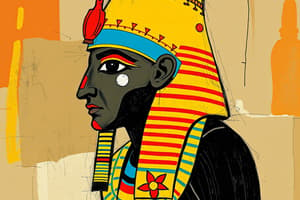Podcast
Questions and Answers
What is the date range of the Palette of King Narmer?
What is the date range of the Palette of King Narmer?
- 3200 - 3150 B.C.E
- 3000 - 2920 B.C.E (correct)
- 2500 - 2400 B.C.E
- 3100 - 3050 B.C.E
Where was the Palette of King Narmer discovered?
Where was the Palette of King Narmer discovered?
Among a group of sacred implements in an early temple of the falcon god Horus at Hierakonpolis.
Describe the physical characteristics of the Palette of King Narmer.
Describe the physical characteristics of the Palette of King Narmer.
More than 2 feet tall, carved palette made of greyish-green siltstone, decorated with detailed low relief on both faces.
What was the Palette of King Narmer used for?
What was the Palette of King Narmer used for?
Why is the Palette of Narmer considered to be so important?
Why is the Palette of Narmer considered to be so important?
What do we see represented on the Palette of King Narmer?
What do we see represented on the Palette of King Narmer?
What are some possible interpretations of the Palette of Narmer?
What are some possible interpretations of the Palette of Narmer?
Flashcards are hidden until you start studying
Study Notes
Palette of King Narmer
- Dates back to 3000 - 2920 B.C.E and is a significant artifact from ancient Egypt.
- Crafted from greyish-green siltstone and measures over 2 feet in height.
- Features intricate low relief decoration on both sides, depicting King Narmer in various scenes.
Discovery and Location
- Unearthed in Hierakonpolis, the first capital of Egypt, as part of a ritual deposit in a temple dedicated to the falcon god Horus.
Functionality
- Serves as a monumental cosmetic palette for grinding and mixing minerals used in cosmetics, likely utilized in temple rituals.
Iconographic Importance
- Notable for its formal characteristics that influenced Egyptian art for three millennia, including:
- Representation of figures and organized scenes in horizontal registers.
- Use of hierarchical scale to signify the importance of individuals.
- Iconography associated with royal regalia: crowns, kilts, royal beard, and more.
Visual Elements and Imagery
- Displays King Narmer depicted twice in human form, alongside a sandal-bearer.
- Narmer may also symbolize a bull, showcasing power through the destruction of a walled city, a motif associated with pharaohs.
- Features two entwined serpopards—mythical leopards—with attendants, defining the makeup preparation area.
- Uppermost register highlights hybrid human-bull heads and features Narmer’s name; the lowest register showcases defeated enemies.
Interpretations of the Palette
- Viewed as a record of the unification of Egypt under Narmer, evidenced by his wearing of both Upper and Lower Egypt crowns.
- Suggested that images may hold ceremonial significance, reflecting themes of order and chaos within Egyptian cosmology.
- May also relate to the solar cycle and the journey of the sun god, a recurring element in Egyptian mythology.
- Scenes depict the victorious Narmer approaching decapitated enemies, encapsulating themes of dominance and divine mandate in his dual crown representation.
Studying That Suits You
Use AI to generate personalized quizzes and flashcards to suit your learning preferences.




